With so many amazing reptiles now integrated into the pet trade, choosing which particular one will suit you best can be tricky and confusing! If you’re an aspiring reptile owner or just can’t decide what your next scaly friend should be, check out this list of our 7 best reptiles to keep as pets!
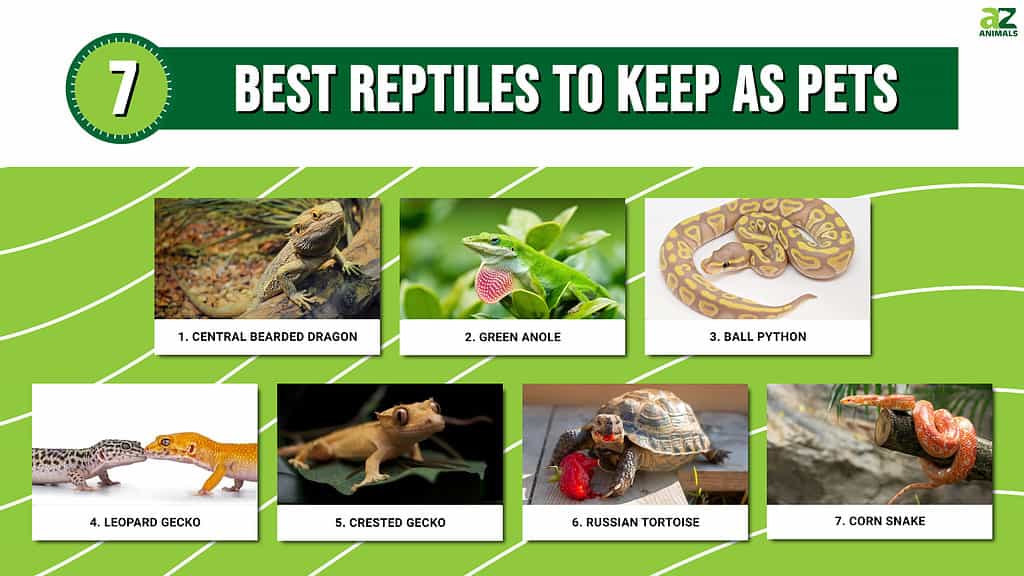
While no exotic pet is truly 100% fuss-free or always “easy” in terms of maintenance and care, this group of lizards, snakes, and more represent some of the most accessible, docile, handleable, hardy, and overall most beginner-friendly reptiles around–and even if you’re a seasoned reptile expert, you’re still likely to find an awesome scaly companion here to add to your personal zoo!
Though they’re not in any particular order, each entry on this list comes with an approximate difficulty level (ranging from beginner to intermediate to expert) as far as the animal’s upkeep and how intensive their care needs are. Additionally, below each reptile’s difficulty level is a rough cost approximation to give you an idea of how much you’ll be spending to properly accommodate them in comparison to other reptiles on the list.
1. Central Bearded Dragon (Pogona vitticeps)
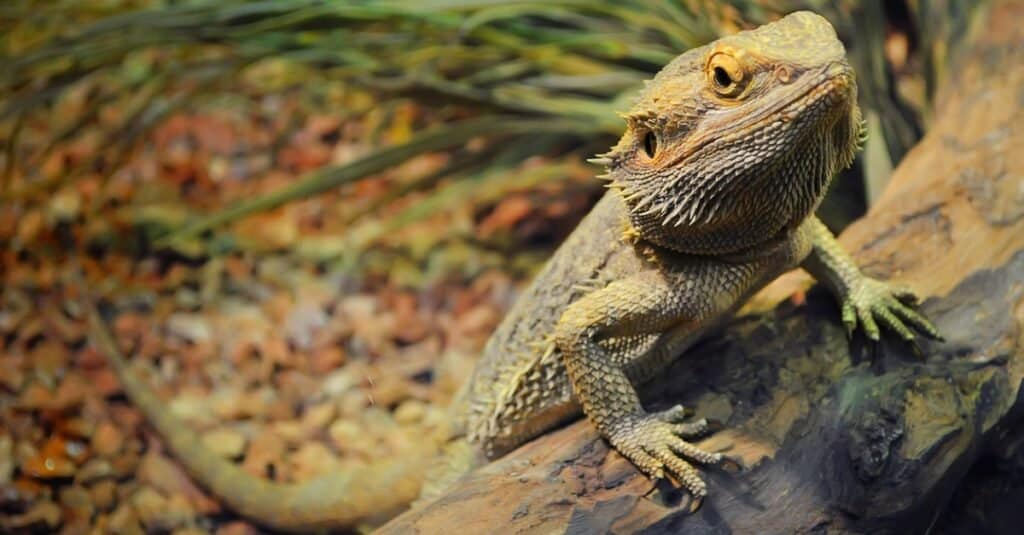
Bearded dragons are hardy, curious, and intelligent.
©Shinedawn/Shutterstock.com
Difficulty Level: Intermediate
Cost: $$-$$$ (Moderate to Expensive)
Lifespan: 8 – 12 years
The lovable, hardy bearded dragon is one of the most popular pet reptiles in the entire world for many great reasons! They are by far one of the most handleable reptiles on this list thanks to their mellow temperaments. As far as accessibility goes, beardies are extremely easy to breed in captivity. This means there’s always an abundance of reptile breeders selling the lizards in a wide range of fun color morphs!
Interestingly, there are actually seven different species of bearded dragons within the Pogona genus. The most popular variety in the pet trade is the central bearded dragon, taxonomically known as Pogona vitticeps.
While bearded dragons are often marketed as ideal beginner pets, they actually have fairly complicated needs, particularly nutritionally and in terms of their enclosure settings. This doesn’t necessarily make them difficult pets, but they can be a challenge at first to those unprepared or new to owning reptiles.
Depending on a dragon’s age, they require a very specific ratio of plant matter to insect protein and a regular calcium supplement to avoid developing severe health issues like metabolic bone disease. And because they’re native to the harsh, unforgiving Australian Outback, they require very hot, dry conditions to thrive in captivity.
Another factor to keep in mind is that bearded dragons are one of the larger, heavier-bodied reptiles listed here. This presents its own unique challenges, mainly that the lizards must be kept in quite large enclosures (ideally at least 60+ gallons) to thrive.
Still, if you are willing to put a bit of extra diligent care into their wellbeing, a bearded dragon is an incredibly rewarding and endlessly entertaining pet reptile.
2. Green Anole (Anolis carolinensis)
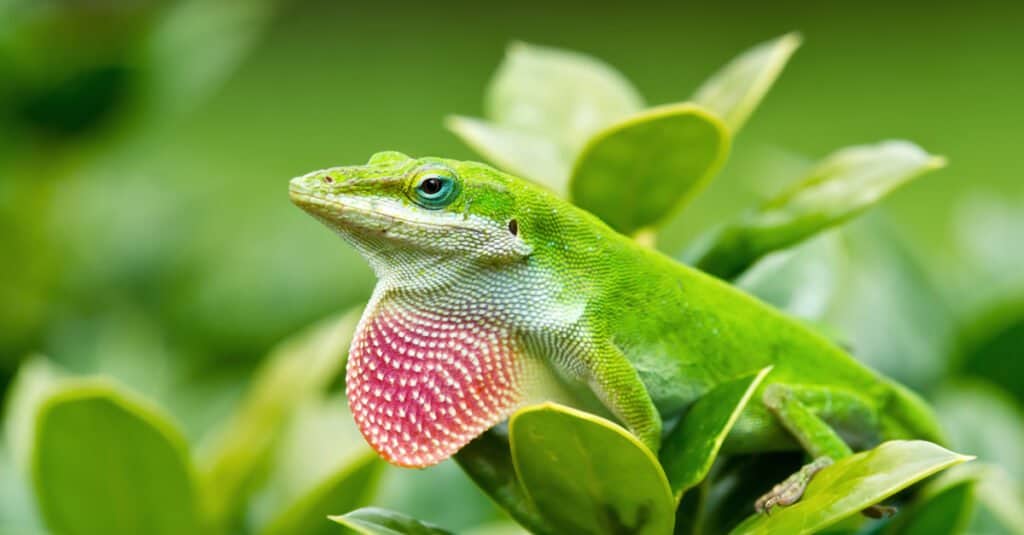
Green anoles are low-maintenance yet entertaining pets.
©Leena Robinson/Shutterstock.com
Difficulty Level: Beginner
Cost: $ (Inexpensive)
Lifespan: 3 to 6 years
Sadly, the humble green anole is sometimes overlooked by reptile owners due to its skittish nature and somewhat short lifespan. But these vibrant little lizards more than make up for these minor drawbacks with their simple care requirements, attractive coloration, and active, curious personalities.
As we touched on earlier, it’s important to remember that there are no truly fuss-free exotic pets. However, the green anole is far and away one of the easiest reptiles to care for. They’re small, inexpensive, and don’t require very large enclosures in captivity. As pure insectivores, their diets consist entirely of small, cheap feeder insects like crickets and mealworms.
This unique-looking lizard’s enclosure conditions are also very simple and straightforward. Anoles are quite hardy lizards and native to various habitats throughout the southeastern US, so they can tolerate a fairly wide range of temperatures and humidity levels. Overall, they fare best in very warm and humid conditions. Because they are highly arboreal, they require lots of branches and ledges for climbing.
One potential drawback of keeping green anoles as pets is their lack of handleability. Because they are so small, they’re very fragile. What’s more, due to their shy and anxious temperaments, they usually don’t enjoy being held or touched.
If you don’t mind not being able to hold and cuddle up with your scaly pal, the green anole is a fantastic pet for beginner and expert reptile lovers alike.
3. Ball Python (Python regius)
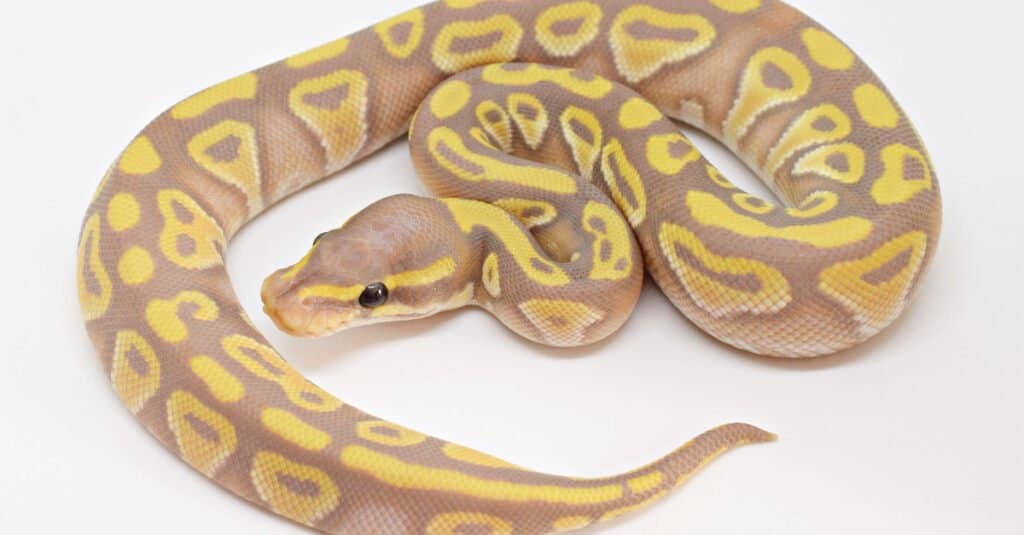
Ball pythons exist in many different color morphs.
©pelsopython/Shutterstock.com
Difficulty Level: Intermediate
Cost: $$ (Moderate)
Lifespan: 20 – 30 years
The first snake on our list, the ball python, is an extremely popular pet amongst reptile lovers. For starters, it’s by far one of the friendliest and most docile snakes in the pet trade, making it a delight to handle and interact with. If you’re set on owning a reptile you can handle and interact with, a ball python is a great choice. Since these snakes breed so easily in captivity, it’s common to find them in hundreds of different color and pattern morphs!
Compared to other popular pet snakes, ball pythons are very small and manageable in size, meaning they only need around 40 to 60 gallons of enclosure space. In fact, they can become overwhelmed easily in very large tanks!
Their enclosure setups are pretty simple, too. They don’t enjoy having much clutter–mainly just substrate, a water bowl for drinking and soaking, and hides. Since they’re native to central Africa, they like it hot and slightly humid.
One thing to keep in mind when considering adopting a ball python, though, is their strictly carnivorous diet. If you’re squeamish about handling frozen mice and rats, this lovely snake might not be the best pet reptile for you personally. On the plus side, ball pythons have slow metabolisms and digest their food slowly. Even baby ball pythons only need to eat twice a week or so!
Overall, ball pythons are right in the middle in terms of both the difficulty and cost of their care. They can be picky eaters, have long lifespans, and require a specific enclosure size to avoid becoming anxious and overwhelmed. On the other hand, though, they’re highly intelligent, friendly, attractive, and incredibly rewarding pets!
4. Leopard Gecko (Eublepharis macularius)
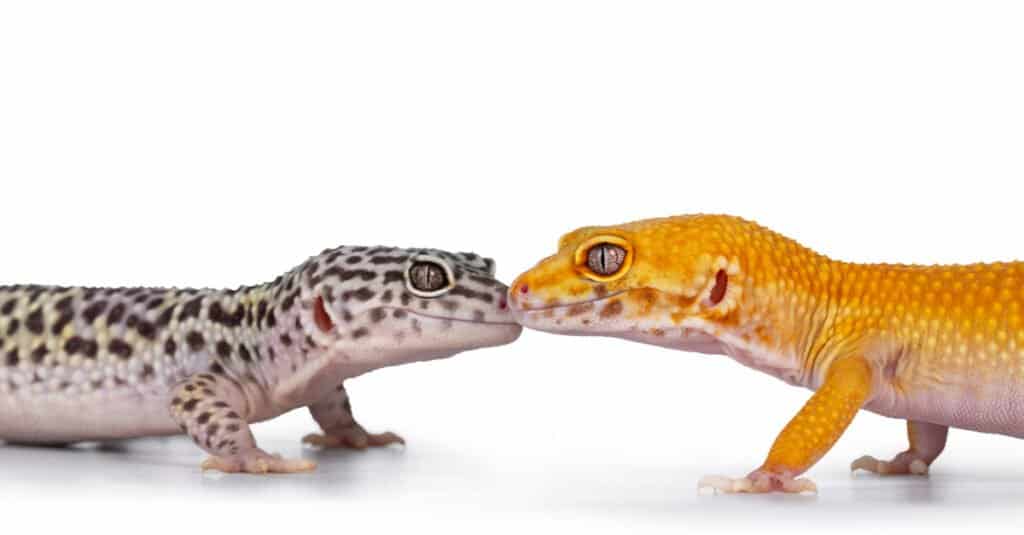
These hardy little geckos are excellent pets due to their simple care needs and quirky personalities.
©Nynke van Holten/Shutterstock.com
Difficulty Level: Beginner-Intermediate
Cost: $ (Inexpensive)
Lifespan: 8 – 15 years
It seems the leopard gecko is always in competition with the bearded dragon for the title of Most Popular Pet Reptile! We find them to be equally delightful and rewarding pets, just in different ways that suit different kinds of pet owners. Wide-eyed, adorable, and the perfect little handful-sized lizards, leopard geckos have become quite popular on various social media platforms for their perpetually “smiling” expressions.
Leopard geckos fall somewhere in between the beginner and intermediate levels as far as the difficulty of their care. They require average-sized enclosures of around 40 to 50 gallons. Because they are mostly solitary and fairly shy, their tanks need plenty of shelter in the form of hides, plants, rocks, and other decor. For this reason, it also is not advisable to cohabitate them.
Native to countries in the Middle East like Iran, Pakistan, and Afghanistan, leopard geckos like it hot and dry! Maintaining these conditions can be tricky at first, particularly for those new to reptile ownership.
Still, despite their rather specific care requirements and somewhat skittish temperaments, leos are hardy, adaptable reptiles. They can grow to tolerate handling very well with careful socialization. Managing their diet is also very straightforward, as they are purely insectivorous. Crickets, mealworms, dubia roaches, and other small, inexpensive feeder insects are all on these lizards’ menus.
Finally, the overall cost of owning a leopard gecko is generally low and manageable. Typically, the initial enclosure setup and occasional vet check-ups are the most costly aspects of their care.
5. Crested Gecko (Correlophus ciliatus)
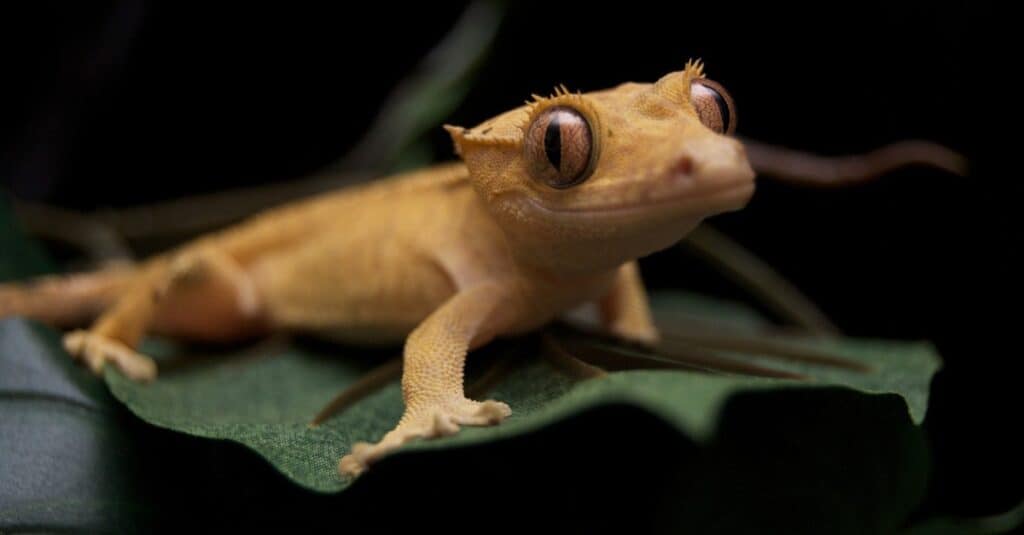
Crested geckos are lots of fun and personality in a tiny package.
©iStock.com/ajbulla
Difficulty Level: Beginner
Cost: $ (Inexpensive)
Lifespan: 15 to 20 years
If the bearded dragon and leopard gecko are the top two most popular pet lizards, this little guy isn’t far behind! Named for its pointy eyelash-shaped crests above each eye, the crested gecko (also known as the eyelash gecko) is an adorable little reptile and a delightful pet, even for beginners.
Interestingly, crested geckos didn’t enter the exotic pet trade in a major way until the late 1990s. This is because they were believed to be extinct until 1994 when they were rediscovered in New Caledonia’s dense, humid forests. They quickly exploded onto the reptile-keeping scene thanks to their simple care requirements, small size, and strangely cute, bug-eyed appearance.
Because crested geckos are arboreal, they need tall, narrow enclosures (around 15 to 20 gallons) with lots of plant cover and ledges for climbing. Plant cover and hides are also necessary for shelter, as the lizards can be shy and skittish. Notably, they’re nocturnal, so they’re most active at night. Their nocturnal nature also means that, unlike most diurnal reptiles, crested geckos don’t require specialized UVB lighting.
When it comes to temperature and humidity, crested geckos like it mild. They tolerate a wide range of temperatures from around 65F to 82F, with their ideal temperature shifting slightly depending on the time of day. Humidity, however, must be kept consistently high at around 70%+ to prevent shedding issues or dehydration.
In short, crested geckos are one of the best pet reptiles for total beginners to the reptile trade, but they’ve also remained very popular amongst reptile experts! They’re especially great for pet owners with limited space, since their enclosures are tall, narrow, and don’t take up much room.
6. Russian Tortoise (Testudo horsfieldii)

Russian tortoises can be a bit challenging to care for, but they’re well worth the effort!
©Elena M. Tarasova/Shutterstock.com
Difficulty Level: Intermediate-Expert
Cost: $$$ (Expensive)
Lifespan: 50+ years
We now come to the only tortoise on this list: the Russian tortoise. Unfortunately, turtles and tortoises have been largely omitted from this selection. Most species have long lifespans, grow to be quite large, and need spacious, sturdy enclosures and specialized diets. However, if you’re up to a bit of a challenge and a lifelong investment, this handsome little tort is an excellent pet.
In terms of its size, the Russian tortoise is modest compared to its relatives in the Testudines family. While most turtles and tortoises grow slowly and constantly, this particular variety maxes out at around 8 to 10 inches. This means their enclosures are smaller than those of other tortoise species (though they still require at least 15 square feet of space!).
Native to Central Asia’s driest, rockiest environments, Russian tortoises are hardy and adaptable! They can tolerate a wide range of temperatures (around 65F to 80F), though they also enjoy having access to a warmer basking spot. Their humidity needs are low and also easily manageable at around 30% to 50%.
One main factor that contributes to the Russian tortoise’s costly, specialized care is its diet. As herbivores, Russian torts must eat fresh greens, flowers, vegetables, and fruits daily. Additionally, a calcium supplement is essential to keep their bones strong and healthy.
Overall, this docile, highly intelligent, and curious reptile is the most expensive and demanding pet on this list. Adopting a Russian tortoise is a lifelong commitment, and caring for them can be costly over time. Still, it’s one of the best pet reptiles, provided you’re willing to give this one-of-a-kind tortoise the TLC it deserves.
7. Corn Snake (Pantherophis guttatus)

Cute, vibrant, and active, corn snakes are entertaining and rewarding pets for reptile keepers of all experience levels.
©KAMONRAT/Shutterstock.com
Difficulty Level: Beginner
Cost: $-$$ (Inexpensive to Moderate)
Lifespan: 10 to 20+ years
Due to its curious, active nature, small size, and inexpensive care, the common corn snake remains one of the best pet snakes in the world. Like many other popular pet reptiles, corn snakes breed easily in captivity, so there are loads of stunning color and pattern morphs available to choose from!
Though they aren’t quite as calm and mellow in nature as ball pythons, corn snakes are much smaller and can tolerate handling just as well with careful, gradual socialization. Babies are especially anxious and shy, but they usually “tame down” over time.
The corn snake’s more slender, diminutive size (around 4 to 5 feet) also means it doesn’t need a particularly large enclosure. Most reptile experts recommend at least 40 to 50 gallons of space for a single adult corn snake. However, bigger is always better! These snakes don’t get overwhelmed by larger enclosures like the aforementioned ball pythons sometimes tend to do.
Like with any snake’s diet, you’ll need to be okay with feeding your corn snake frozen (thawed before feeding!) rodents. Fortunately, adult corns only need to eat once a week or so, meaning mealtimes are brief, infrequent, and–perhaps most importantly if you’re working with a limited budget–inexpensive.
In short, it makes sense why corn snakes have been such popular pet reptiles for so many years. Whether you’re new to owning reptiles or looking to add yet another scaly friend to your personal zoo, these colorful little snakes are always an excellent choice.
Summary of 7 Best Reptiles to Keep as Pets
| Rank | Reptile | Difficulty Level | Cost | Lifespan |
|---|---|---|---|---|
| 1 | Central Bearded Dragon | Intermediate | Moderate to Expensive | 8-12 years |
| 2 | Green Anole | Beginner | Inexpensive | 3-6 years |
| 3 | Ball Python | Intermediate | Moderate | 20-30years |
| 4 | Leopard Gecko | Beginner to Intermediate | Inexpensive | 8-15 years |
| 5 | Crested Gecko | Beginner | Inexpensive | 15-20 years |
| 6 | Russian Tortoise | Intermediate to Expert | Expensive | 50+ years |
| 7 | Corn Snake | Beginner | Inexpensive to Moderate | 10-20+ years |
The photo featured at the top of this post is © Nynke van Holten/Shutterstock.com
Thank you for reading! Have some feedback for us? Contact the AZ Animals editorial team.







